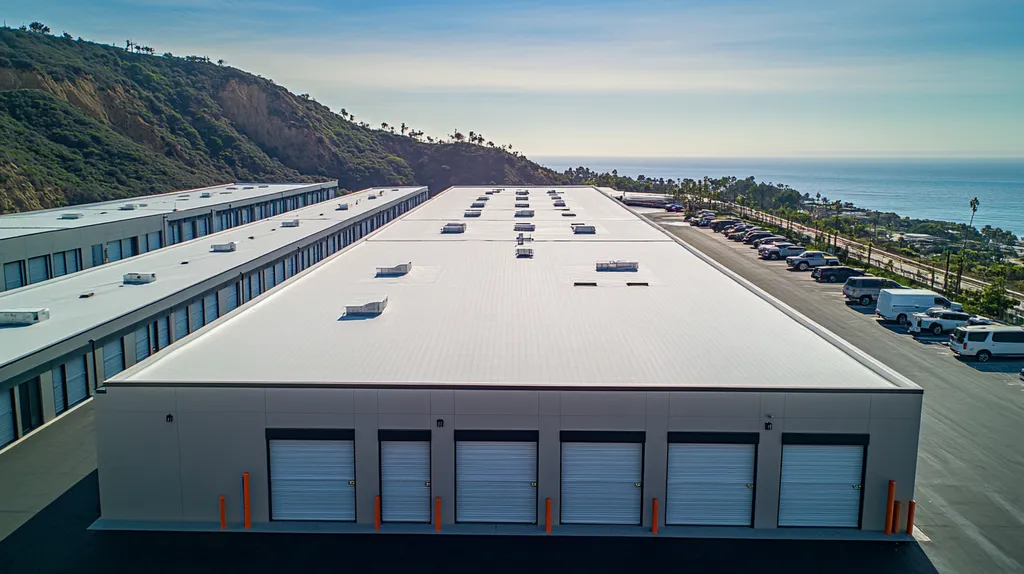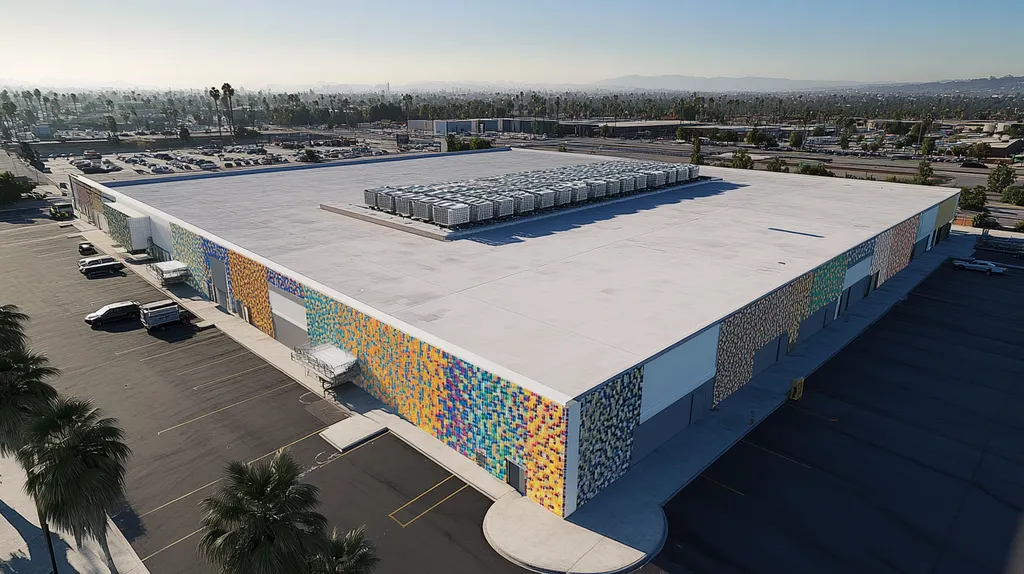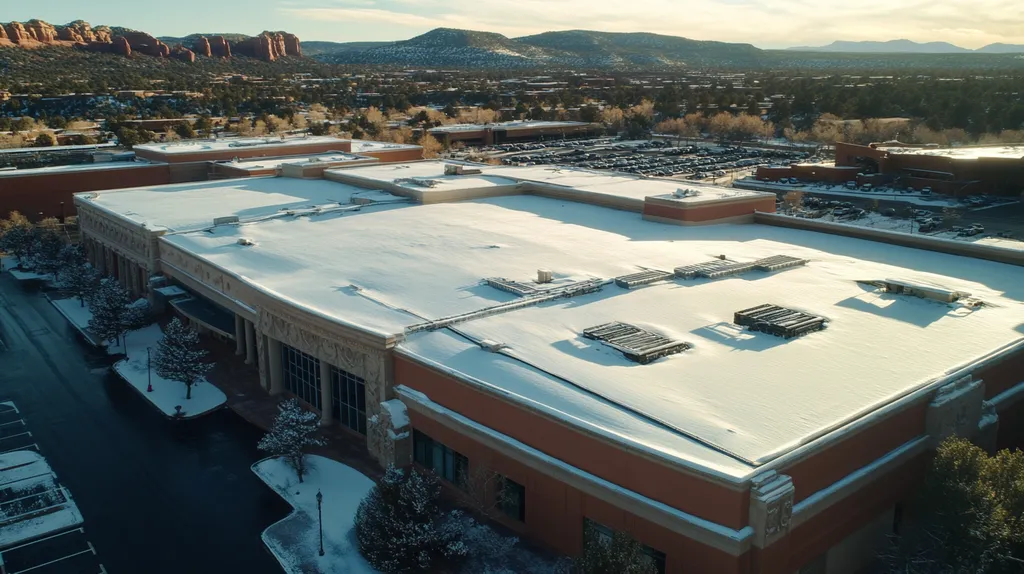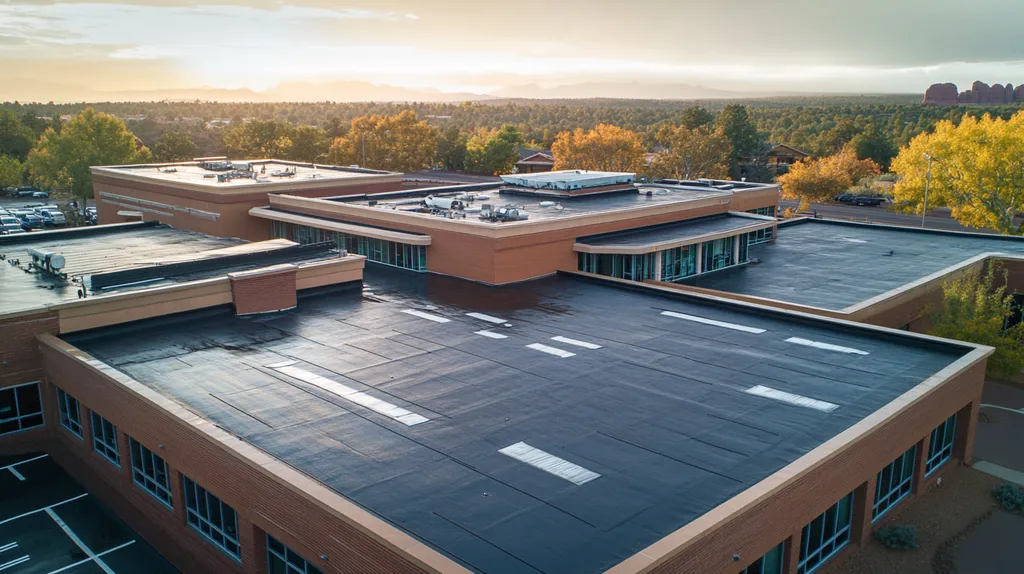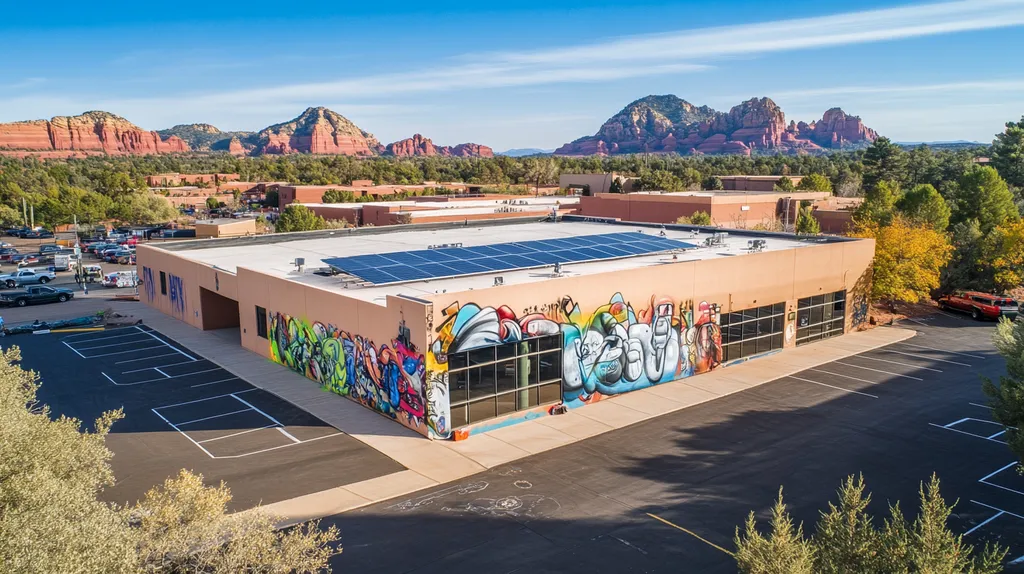In humid climates, commercial roof coatings are failing at an alarming rate, with 40% of traditional applications deteriorating within half their expected lifespan. This systematic failure costs property owners millions in premature replacements and repairs annually.
While the industry continues to push conventional moisture control solutions, mounting evidence suggests these standard approaches are fundamentally flawed. From trapped moisture to compromised structural integrity, the consequences of inadequate coating choices cascade throughout building operations.
This analysis examines why typical humidity solutions fall short and explores the often-overlooked alternatives that could revolutionize commercial roof protection in challenging climates.
SECTION 1: CURRENT PRACTICES
In humid climates, the stakes for commercial roofs are notably high, with the potential for skyrocketing maintenance costs and dramatically shortened lifespans. Research indicates that roofs in these regions endure accelerated wear due to moisture infiltration and rampant algae growth. For property owners and facility managers, understanding the urgency of implementing effective humidity control methods is essential to safeguard their investments.
Common Humidity Control Methods
Property owners frequently lean on a narrow range of humidity control strategies, such as exhaust fans and dehumidifiers. While these can provide momentary respite, they often fall short of strengthening the roof against the grip of relentless moisture in humid climates. For example, exhaust fans can lower indoor humidity levels but fail to tackle moisture intrusion through the roof itself.
Some facilities also depend on passive ventilation systems, which are designed to take advantage of natural airflow. Yet this strategy can be hit-or-miss, leaving behind humidity pockets that invite leaks and mold growth over time. This inconsistency can transform roofs into breeding grounds for problems that could have been prevented with proactive measures.
Moreover, conventional coatings or materials used in these environments often struggle to meet the long-term demands of commercial roofs. Choosing inadequate solutions only leads to a cycle of frequent repairs, which pose safety risks and financial burdens that continue to mount.
Unexpectedly, many property owners remain blissfully unaware of the cutting-edge humidity control techniques available today. While roofing technology continues to develop, the industry frequently remains stuck in outdated practices that do not align with the dynamic requirements of modern commercial buildings.
Standard Application Procedures
Standard application procedures for roof coatings in humid climates typically adopt a one-size-fits-all philosophy. This means applying generic coatings without tailoring the approach to manage moisture effectively. Consequently, many roofs end up with products that don’t quite match the needs of humid conditions.
The typical approach involves cleaning the roof surface, then layering on a primer and topcoat. However, this method often overlooks ambient humidity levels during installation, which can jeopardize proper adhesion and the coating’s longevity. In humid environments, timing and prevailing conditions must be meticulously managed to avoid sticky complications.
Furthermore, existing procedures often gloss over the need for specialized techniques like applying multiple coatings or using moisture-resistant materials. These could be essential for overcoming the unique challenges of humid climates, yet remain underused in practice.
Flawed application not only jeopardizes the integrity of the roof but also lessens the performance of even the highest-quality products. Grasping the significance of proper application can dramatically enhance the lifespan and functionality of commercial roofing systems.
Typical Material Choices
When it comes to material choices for roofing systems in humid climates, options are often restricted to a limited lineup, such as asphalt and single-ply membranes. While these may be common, they aren’t always the best match for high-moisture settings. Properties in these regions frequently experience disappointing performance with these conventional materials.
Moreover, typical coatings, particularly those made from elastomeric or acrylic materials, can suffer from limited breathability, exacerbating moisture retention issues. Over time, this can result in bubbling and delamination, allowing structural integrity to erode.
In contrast, innovative polymer-based coatings, designed specifically for humidity management, can significantly outperform traditional materials. These advanced solutions offer enhanced reflectivity, improved elasticity, and superior moisture control—yet they still struggle for acceptance in the marketplace.
Sticking to conventional material choices can ultimately stymie a property’s sustainability and drive up operational costs. Embracing innovative materials isn’t just advisable; it’s critical for ensuring the long-term health of roofing systems in humid climates.
SECTION 2: SYSTEMIC ISSUES
In the world of commercial roofing, humid climates pose unique challenges that many traditional coatings fail to tackle effectively. This oversight can spell disaster, leading to extensive long-term damage and hefty repair costs. Alarmingly, research reveals that moisture-related issues can trim a roof’s life by up to 50%, making the case for innovative solutions clearer than ever.
Inadequate Moisture Management
Many commercial roofing systems rely on coatings that woefully lack effective moisture control. This shortcoming allows moisture to become trapped beneath the surface, creating a cozy home for mold and algae to flourish.
Take, for instance, a flat roof with inefficient drainage; it can hold water for prolonged periods, worsening moisture woes. This situation can culminate in structural damage, unsightly leaks, and the grim necessity of premature roof replacements.
Moreover, inadequate moisture management can lead to thermal degradation. As coatings age, their reflective properties fade, causing energy costs for cooling to soar.
This pattern reveals a pressing dilemma for property owners, as maintenance costs skyrocket and tenant satisfaction teeters on the edge. Without a proactive strategy, the health of roofs in humid climates remains precarious.
Limited Durability and Lifespan
Conventional roof coatings often lack the fortitude to handle the distinctive challenges presented by high humidity. These coatings tend to degrade at a brisk pace, resulting in a drastically shortened lifespan.
For example, studies reveal that coatings in humid climates may need reapplication every five years, whereas their counterparts in drier regions can stretch to ten or even fifteen years. This disparity not only elevates maintenance expenses but also disrupts daily business operations.
The ramifications of ignoring durability extend beyond immediate repair demands. Severe damage may require complete roof replacement, leading to even steeper costs down the road.
Furthermore, limited durability can erode stakeholder confidence. Property owners risk losing tenants if their roofs fail to uphold optimal conditions over time. The financial impact of depending on inferior coatings is nothing short of staggering.
Environmental Impact of VOCs
Many conventional roofing coatings are tainted with volatile organic compounds (VOCs), notorious contributors to environmental pollution. These compounds can release harmful chemicals into the atmosphere, jeopardizing both ecological health and human well-being.
In humid climates, the adverse effects of these emissions can be intensified as the moist air traps pollutants, leading to deteriorating air quality indoors and out.
Moreover, regulations surrounding VOCs are tightening. Property owners may soon face fines or the daunting task of upgrading their roofing systems to comply with new standards.
By opting for low-VOC or VOC-free alternatives, property owners can shrink their environmental footprint while showcasing a commitment to sustainability that enhances their business image.
In today’s market, eco-friendly roofing extends beyond mere regulatory compliance; it’s fast becoming a smart business strategy that can provide a competitive edge.
SECTION 3: MISSED OPPORTUNITIES
Ignoring effective roof coatings in humid climates can spell disaster for commercial properties, leading to long-term challenges that could have been avoided. Many property owners and facility managers miss vital options that would dramatically enhance roof performance and longevity. This section highlights critical oversights that can reshape roofing strategies, focusing on durability and cost-effectiveness. Recognizing these missed opportunities is essential for sustainable roofing management.
Overlooking Breathable Coatings
One of the most glaring oversights by property owners involves neglecting breathable roof coatings. In humid climates, conventional coatings can seal in moisture, leading to disastrous roofing failures. Breathable options, on the other hand, allow trapped moisture to escape, significantly extending the roof’s lifespan.
Choosing traditional coatings may seem like a cost-effective approach initially, but it often results in costly repairs later on. For instance, a choice made today can lead to structural damage, leaks, and mold growth, elevating maintenance expenses and health risks for tenants. Embracing breathable coatings not only protects investments but also enhances occupant health and comfort.
In the world of commercial roofing, overlooking breathable coatings is akin to locking the door while leaving the window ajar. A proactive management strategy that prioritizes breathable coatings can prevent the damaging cycle of repairs, ensuring a more resilient and dependable roofing system.
Ignoring Energy Efficiency Gains
Another critical opportunity overlooked by many facility managers is the advancement of energy-efficient roofing solutions. Reflective roof coatings can drastically reduce surface temperatures, lowering cooling costs in humid regions. Yet, countless building managers cling to outdated materials that miss the mark on energy efficiency.
The costs of inaction are steep. Reflective coatings have been shown to cut energy bills by up to 30%. Sticking with inefficient options not only inflates operational costs but also adds to a facility’s carbon footprint. By investing in energy-efficient coatings, property owners can reap the rewards through significant energy savings.
Besides the financial benefits, energy-efficient coatings improve overall building performance. Reduced energy consumption equates to a smaller carbon footprint, appealing to sustainability-minded tenants or clients. Recognizing the importance of energy efficiency is about positioning properties for the future while enjoying immediate rewards.
Neglecting Long-Term Cost Savings
A common blunder among facility managers is underestimating the long-term cost savings connected with high-quality roof coatings. Though premium coatings may appear pricier upfront, their durability translates into significantly lower maintenance costs over time. Frequent repairs and patching can drain budgets, diverting funds from other essential areas.
Consider this: a superior coating can withstand moisture and UV exposure for up to 20 years, while inferior solutions might need replacing in just five. This cycle of temporary fixes strains financial resources and puts overall building safety at risk. Property owners should also consider indirect costs from inefficient roofing, like increased energy consumption and tenant dissatisfaction.
By focusing on long-lasting roof coatings, facility managers can ensure thoughtful resource allocation and protect their investments. Opting for high-quality solutions lays the foundation for a sustainable and financially viable roofing strategy that promises peace of mind well into the future.
SECTION 4: ROOT CAUSES
The challenges of maintaining commercial roofs in humid climates are complicated by several key underlying issues. Understanding these root causes is essential, as failing to address them can result in costly repercussions. Shockingly, nearly 60% of commercial roofs fail prematurely due to improper coatings—a statistic that underscores the need for awareness. In this section, critical issues are examined: lack of regulatory enforcement, insufficient training, and the market’s ongoing reliance on outdated products.
Lack of Regulatory Enforcement
Regulatory bodies play a vital role in ensuring roofing materials adhere to established performance standards. Unfortunately, enforcement tends to be lax in many regions, letting subpar products seep into the market. This creates confusion for property owners trying to discern what qualifies as an effective roof coating.
The lack of stringent regulations paves the way for low-quality coatings ill-suited for humid climates. Such products often fail to guard against moisture, setting the stage for mold growth and structural damage. As these problems compound, property owners find themselves facing soaring repair costs and potential health risks.
Moreover, with little regulatory guidance, property owners are left to navigate a maze of options. This lack of clarity can result in investments in ineffective solutions that ultimately compromise roof performance and longevity.
This regulatory shortfall affects not just individual roofs but ripples through the entire industry. Suppliers, chasing profit margins, may prioritize cheaper, less effective products, complicating the choices for uninformed consumers.
Insufficient Training and Education
The intricacies of commercial roofing systems demand specialized knowledge, yet many contractors and facility managers lack the training to make informed decisions about coatings and their application. This gap in expertise can have dire effects on roof integrity, particularly in humid settings.
Consequently, inappropriate installation practices often lead to premature failures and inflated maintenance costs. Instead of thoroughly evaluating the distinctive challenges posed by humidity, many contractors resort to quick fixes, overlooking how humidity impacts the curing and bonding of coatings.
Additionally, the scarcity of educational resources restricts awareness of advanced techniques and best practices. Without ongoing training, roofing professionals may remain stuck using outdated methods that fail to accommodate modern materials and environmental factors.
As the industry evolves, so too must the knowledge of those within it. Enhancing training programs can empower professionals to identify effective solutions for humid climates, resulting in better outcomes for property owners.
Market Dominance of Outdated Products
The roofing supply market is often saturated with traditional products that may not adequately address current environmental challenges. These outdated coatings frequently lack the durability necessary for humid conditions, leaving many roofs susceptible to damage.
For instance, older acrylic and tar-based coatings can trap moisture, fostering an ideal environment for mold and degradation. While these products may demonstrate acceptable short-term performance, their long-term effectiveness is questionable—and costly when repairs are necessary.
This dependency on legacy products stifles innovation within the industry. Manufacturers may be reluctant to invest in newer formulations suited for the unique challenges of humid environments due to limited market demand and consumer education. This dynamic perpetuates a cycle that allows outdated solutions to continue misguiding property owners.
Ultimately, the prevalence of inferior products highlights the pressing need for a collective push towards modern alternatives that withstand the rigors of humidity. Property owners and facility managers must advocate for better options to break free from this cycle and protect their investments.
DATA DRIVEN EVIDENCE
In the relentless humidity of certain climates, commercial roofs face a silent but significant threat: moisture-related issues that can wreak havoc on roof integrity. Traditional coatings often lack the resilience needed to withstand this moisture onslaught, leading to premature failures and costly repairs. Alarmingly, nearly 40% of commercial roofs succumb to deterioration due to inadequate moisture protection. This section dives deep into the disappointing performance metrics of conventional coatings, shines a light on comparative studies examining innovative alternatives, and presents compelling case studies that reveal the benefits of newer solutions.
Performance Metrics of Traditional Coatings
Traditional roof coatings are struggling to keep up in humid environments. For example, studies show elastomeric coatings may last a mere five to seven years under excessive moisture conditions. These products frequently suffer from poor adhesion and are prone to blistering, leading to leaks that compromise the entire roofing system.
Worse yet, traditional options often require annual maintenance, which can add up over time. Buildings equipped with these coatings typically face an average increase of 30% in maintenance costs compared to those utilizing advanced alternatives. Given the rising repair costs, property owners are increasingly compelled to seek better solutions.
The current reliance on outdated materials is becoming a glaring issue. It’s essential for property managers to prioritize coatings that can endure the challenges of humid climates in order to achieve longer-lasting protection.
This critical situation underscores the urgency for change. The spiraling maintenance costs should push property owners to consider effective alternatives with superior performance metrics when selecting roofing solutions.
Comparative Studies on New Technologies
Recent advancements in roofing technology have heralded the arrival of coatings specifically engineered for humid climates. Comparative studies illuminate that these innovative formulations excel in moisture resistance. For instance, silicone-based coatings have demonstrated lifespans of up to 15 years—significantly surpassing their traditional counterparts.
These cutting-edge products provide superior adhesion and flexibility, crucial characteristics for humid conditions. Research indicates they can endure ponding water without degrading, thus minimizing leakage risks. Facilities that have switched to these modern technologies report an impressive 50% reduction in moisture-related issues.
Moreover, innovative coatings often feature lower thermal expansion rates, enhancing their durability during temperature fluctuations. This improved performance not only safeguards the roof but also contributes to energy efficiency gains, making a persuasive financial argument for the investment.
As the roofing industry progresses, the adoption of these advanced technologies is vital. Property owners investing in next-generation coatings can expect better performance outcomes and a more manageable cost structure.
Case Studies of Successful Alternatives
Numerous commercial facilities have effectively implemented advanced roof coatings to address humidity challenges. A prime example is a manufacturing plant that transitioned from a traditional acrylic coating to a silicone-based system. Following this change, data revealed a staggering 70% reduction in maintenance calls, with the roof’s lifespan extended by over a decade.
Another success story comes from a retail center that battled persistent leaks during rainy seasons. After opting for a polyurea coating tailored for humid conditions, the center experienced a complete cessation of leak incidents. This proactive measure not only eliminated repair expenses but also boosted customer satisfaction.
Data points from these case studies clearly indicate a trend: roofs employing modern coatings encounter significantly fewer issues while achieving substantial savings. These instances provide compelling evidence supporting the move away from outdated roofing practices.
Investing in proven alternatives is not just a cost-saving exercise; it’s also a strategic choice that ensures long-term stability and success for commercial properties in humid climates.
SECTION 6: ALTERNATIVE SOLUTIONS
As commercial and industrial owners grapple with the challenges of humid climates, the demand for effective roof coatings is more critical than ever. Traditional methods often falter, resulting in costly repairs and perpetual maintenance. Fortunately, innovative alternatives can significantly enhance roof longevity and performance while also reducing environmental impact. This section delves into several promising options, underscoring the importance of informed decision-making in roofing strategy.
Water-Based Elastomeric Coatings
Water-based elastomeric coatings are rapidly gaining traction as a strong contender in humid climates. Designed to flex with temperature changes, these coatings create a reliable barrier against moisture, effectively preventing cracks and other damage that humidity can cause.
Additionally, these coatings generally feature low levels of volatile organic compounds (VOCs), enhancing safety for those applying them and benefiting the environment. Their enhanced breathability allows moisture to escape, thus minimizing the risk of mold or mildew buildup beneath the surface.
For property owners, roofs treated with water-based elastomeric coatings can enjoy an extended lifespan of up to 15 years. Such longevity makes this option a wise investment for both performance and durability.
Another perk? Their application process requires minimal preparation or specialized equipment. This streamlined approach can significantly cut labor costs and complexity, attracting facility managers seeking efficient and effective solutions.
High-Reflectivity and Elastomeric Options
High-reflectivity coatings are vital for reducing heat absorption, a critical feature in humid climates. By reflecting solar energy, these coatings maintain cooler indoor environments, leading to reduced energy costs. Property owners can see substantial savings on their utility bills by cutting down on air conditioning needs.
Unlike standard coatings, high-reflectivity options not only boost roof performance but also enhance comfort for building occupants. Their energy-efficient design aligns with regulations that promote sustainable building practices.
The elastomeric properties of these coatings further contribute to their advantages. They provide a seamless waterproof barrier, which guards against leaks and prolongs the roof’s life. Facilities focused on long-term financial planning should consider the cost benefits related to decreased maintenance expenditures.
On top of their practical benefits, a well-applied high-reflectivity and elastomeric coating can also elevate a building’s aesthetic appeal. This modernization can boost property value and attract tenants who prioritize energy efficiency.
Eco-Friendly and VOC-Compliant Coatings
Amid growing environmental concerns, eco-friendly coatings have emerged as a sustainable choice for roofing. Formulated to meet stringent VOC regulations, these products significantly minimize harmful emissions during application. This shift mirrors a broader industry trend towards sustainability, resonating with property owners seeking responsible solutions.
Despite being eco-friendly, these coatings maintain excellent functionality, successfully resisting moisture, UV rays, and temperature fluctuations. This makes them perfectly suited for humid climates while caring for the planet.
Choosing VOC-compliant coatings can enhance a company’s commitment to corporate responsibility, improving public perception and catering to eco-conscious tenants or clients in search of sustainable spaces.
Moreover, investments in eco-friendly roofing solutions may qualify for local government incentives or rebates, helping to offset initial costs. This makes them not only a strategic choice for sustainability but also a savvy financial decision for astute property managers.
The Bottom Line
With 40% of commercial roofs in humid climates failing prematurely due to inadequate coatings, the industry stands at a critical crossroads.
Traditional solutions continue to fall short, costing property owners millions in repairs while innovative alternatives remain underutilized.
The data clearly shows that water-based elastomeric coatings, high-reflectivity options, and VOC-compliant solutions dramatically outperform conventional methods, extending roof life by up to 15 years.
As regulations tighten and energy costs rise, facility managers who cling to outdated coating practices risk not just their roofs, but their bottom lines.
The choice is clear: embrace modern coating technologies engineered for humidity, or face the mounting costs of maintaining increasingly vulnerable roofing systems.
FREQUENTLY ASKED QUESTIONS
Q. What are the current challenges for commercial roofs in humid climates?
A. Commercial roofs face significant wear due to moisture infiltration and algae growth. Traditional humidity control methods like exhaust fans and dehumidifiers often fall short, leading to premature roof failures and inflated maintenance costs. Understanding these challenges is crucial for effective roof management.
Q. How can inadequate moisture management affect my industrial roof?
A. Inadequate moisture management can trap water and promote mold growth on your industrial roof. This situation may lead to severe structural damage and a significant decrease in the roof’s lifespan, resulting in costly repairs and decreased tenant satisfaction.
Q. What important opportunities are property owners missing for their roofs?
A. Many property owners overlook the value of breathable coatings and energy-efficient solutions. These options can significantly enhance a roof’s durability, prevent moisture accumulation, and lower energy costs, ultimately saving property owners money on maintenance and repairs.
Q. Why is lack of regulatory enforcement problematic for commercial roofs?
A. The absence of strict regulatory oversight allows subpar products to flood the market, leading to poor performance. This situation increases repair costs and health risks for property owners, making it essential to advocate for better regulations in roofing materials.
Q. What do studies say about traditional coatings in humid climates?
A. Studies reveal that traditional coatings often last only five to seven years in humid conditions. They struggle with adhesion and develop leaks, leading to increased maintenance costs compared to modern alternatives designed for effective moisture control.
Q. What are the benefits of eco-friendly roof coatings?
A. Eco-friendly coatings significantly reduce harmful emissions and successfully resist moisture and UV rays. Investing in these products improves your property’s sustainability image and may qualify you for local government incentives, making them a smart financial choice.
Q. What unique features make high-reflectivity coatings an excellent choice?
A. High-reflectivity coatings reduce heat absorption, lowering cooling costs in humid climates. They also offer a seamless waterproof barrier, increasing the roof’s longevity, making them advantageous for both comfort and energy efficiency.


